
speech disorders.pptx-Describe various educational needs of students with sensory disabilities.
- 2. LEARNING OUTCOMES After reading this chapter/unit, you will be able to: Provide an overview of students with Speech impairments/disabilities. Describe the concept of speech impairment. Describe the characteristics of students with various speech disabilities. Describe various educational needs of students with sensory disabilities.
- 3. INTRODUCTION Communication is an important means to connect each other. There are two types of communication namely, verbal and non-verbal. Effective verbal communication requires speech or, speaking ability. Among many causes, if any disorder appears in voice producing organs, it may result in speech impairment and can interfere in learning.
- 4. DEFINITION As per NSSO (2002) “Speech disability refers to person’s inability to speak properly. Speech of a person is judged to be disordered if the person’s speech is not understood by the listener. Persons with speech disability include those who could not speak, spoke only with limited words or those with loss of voice.
- 6. CLASSIFICATION Speech impairments where the child produces sounds incorrectly can be categorized as follows: Articulation Articulation refers to correct production of speech sounds of a language. About 3 out of 5 all speech impairments occur due to articulatory disorders (Karanth, 2009). Distortions Sounds changed so that the intended sound is recognized, but sounds incorrect, speech of a person with a lisp.
- 7. CLASSIFICATION Substitutions Substituting one sound for another (i.e. “doze” for those) Omissions Omitting certain sounds (i.e. “cool” for school or “pos” for post) Additions Addition of extra sound (i.e. “buhrown” for brown)
- 8. CLASSIFICATION Fluency Speech impairments where a child’s flow of speech is disrupted by sounds, syllables and words that are repeated, prolonged, or avoided and where there may be silent blocks or inappropriate inhalation, exhalation, or phonation pattern. Stuttering Rapid fire repetitions of consonant or vowel. Cluttering Rapid speech with extra sounds or mispronounced sounds Stuttering vs. Cluttering Involves both cluttering and stuttering.
- 9. CLASSIFICATION Voice Abnormal production or absence of vocal quality, pitch, loudness, resonance and/or duration, which is appropriate for an individual’s age or sex.” (ASHA, 1993).Speech impairments where the child’s voice has an abnormal quality to its pitch, resonance, or loudness can be divided into two distinct categories: Phonation Disorder Causes the voice to sound hoarse, husky or strained. Severely, there is no voice at all. Resonance Disorder Too many sounds coming out through the air passages of the nose (hyper nasality)or not enough resonance of the nasal passages (hypo nasality)
- 10. CLASSIFICATION Language Language impairment where the child has problems expressing needs, ideas, or information, and/or in understanding what others say. It includes deficiency in receptive language skills to gain information; deficiency in expressive language skills to communicate information; and deficiency in processing (auditory perception) skills to organize information
- 11. WHAT CAUSES SPEECH SOUND DISORDERS IN A CHILD? • Injury to the brain. • Thinking or development disability. • Problems with hearing or hearing loss, such as past ear infections. • Physical problems that affect speech, such cleft palate or cleft lip. • Disorders affecting the nerves involved in speech.
- 12. CAUSES OF ADULT SPEECH IMPAIRMENT • stroke. • traumatic brain injury. • degenerative neurological or motor disorder. • injury or illness that affects your vocal cords. • dementia.
- 13. Voice Impairment – Assessment of vocal characteristics shall include the following: hearing screening; examination by an otolaryngologist; oral peripheral examination; and documentation, including observation and/or assessment, Assessment
- 14. Assessment Fluency Impairment – Assessment of fluency shall include the following: hearing screening Information obtained from parents, students, and teacher(s) regarding non fluent behaviours/attitudes across communication situational peripheral examination; and documentation, including observation and/or assessment.
- 15. Characteristics of language disorders Some characteristics of language disorders include: improper use of words and their meanings, inability to express ideas, inappropriate grammatical patterns, reduced vocabulary, and Inability to follow directions
- 16. Teaching Strategies and Intervention Teaching Strategies and Intervention for Children with Speech Impairment Concepts using actual objects and progress from the concrete to the abstract. Seating positions that facilitate the use of prompts, cues or other strategies during learning and teaching. Important to ensure that the student’s attention has been secured. Slower speech rate to facilitate the processing of information.
- 17. Teaching Strategies and Intervention Use of gestures to help students with severe receptive language disorder understands the meaning of a word that symbolizes an object or an action. Age appropriate instructions help to involve the students in selecting the strategy that works best for them Use of pictures or photographs to reinforce and to develop vocabulary of the students. Radio/television broadcasts, puppetry, telephoning, and role playing can be used to develop oral language activities.
- 18. • Co-operative learning model can be applied to enhance skills Avoiding the role that misunderstanding can have social problems. The Speech-Language Pathologist (SLP) provides classroom teachers with information regarding communication development and possible communication concerns through team meetings and training sessions.
- 19. The SLP also provides suggestions for addressing specific areas of concern through modelling and examples of expansion and other techniques. Teacher or parent may bring communication concerns to the Student Support Team (SST) for consideration. If a student presents with an obvious disability, the SST should expedite the referral for a Full and Individual Evaluation (FIE).
- 21. 1.How will you identify early the symptoms of Speech-impairment in school going children? 2. How will you help students with speech and language disorders in the classroom?